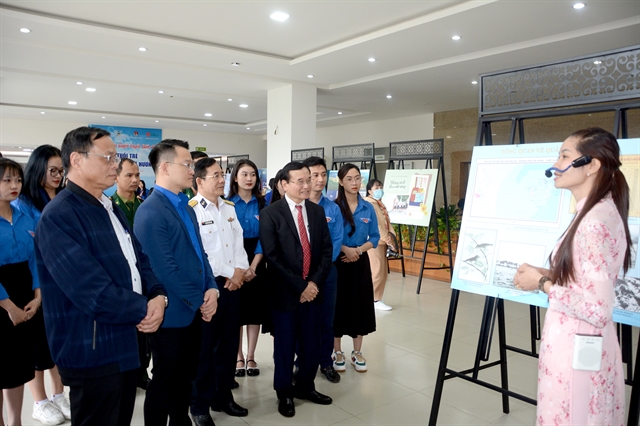 Politics & Law
Politics & Law

 |
| An exhibition on Việt Nam's sovereignty over Hoàng Sa and Trường Sa archipelagoes took place at the Hoàng Sa Exhibition Centre in Đà Nẵng in early January. VNA/VNS Photo Văn Dũng |
HÀ NỘI — Hoàng Sa (Paracel) and Trường Sa (Spratly) archipelagos have always been sacred integral parts of Việt Nam, and the country has historical evidence and a fully legal basis for affirming its sovereignty over the two island chains following international law. Now, an exhibition centre is displaying the evidence.
The Hoàng Sa exhibition centre, located on Hoàng Sa Street, Sơn Trà District, in the central coastal city of Đà Nẵng, displays and archives historical documents, exhibits and images which testify to Việt Nam’s legitimate sovereignty over the two archipelagos.
Since being put into operation in March 2018, the exhibition centre has popularised and affirmed Việt Nam’s sovereignty over Hoàng Sa and Trường Sa archipelagos, thereby promoting the spirit and will to protect the homeland’s territory among the people.
Built on a total area of 1,296 sq.m, the centre holds special political significance as it displays information, documents and images evidencing Việt Nam’s exploration, establishment and protection of the country’s sovereignty over Hoàng Sa and Trường Sa archipelagos.
The centre has the shape of the sovereignty seal in the Nguyễn Dynasty (1802 – 1945), which is meant to show that Việt Nam established and exercised sovereignty over Hoàng Sa very early. Notably, that King Minh Mạng of the Nguyễn Dynasty put the seal on a document setting up the Hoàng Sa flotilla was one of the important landmarks in the establishment and exercise of this indisputable sovereignty.
Exhibits are showcased on five topics, namely the geographical location and natural conditions of Hoàng Sa, Hoàng Sa in Việt Nam’s ancient documents before the Nguyễn Dynasty, Hoàng Sa in documents during the Nguyễn Dynasty, evidence of Việt Nam’s sovereignty over Hoàng Sa from 1945 to 1974, and evidence of the sovereignty since 1974.
Each picture, document, map and exhibit displayed at the centre is valuable in terms of historical and legal foundation proving Việt Nam’s sovereignty over the Hoàng Sa and Trường Sa archipelagos. It also has sacred treasures strengthening the pride and the will towards the preservation and protection of the homeland’s islands of over 100 million Vietnamese people living inside and outside the country.
For example, plate No. 24 inscribed with part of the 10th volume of “Đại Nam Thực lục Tiền biên” (Early Chronicle of Đại Nam) displayed at the centre says: “In the sea off the coast of Vĩnh An Commune of Bình Sơn District, Quảng Ngãi Province, there are more than 130 sand banks … stretching for several thousands of miles called Vạn Lý Hoàng Sa – the eternal yellow sand bank. On these sand banks, there are fresh water and seafood like sea cucumber and hawksbill turtle… In the early period of the dynasty, a Hoàng Sa flotilla was set up with 70 members from An Vĩnh Commune. Every year, they begin sailing in March and reach the bank in about three days to seek natural produce and then return to hand over the produce in August.”
A map compiled in the Lê Dynasty (18th century), a part of “Thiên hạ bản đồ” (a map of Việt Nam’s air and land territories), is also on display at the Hoàng Sa exhibition centre.
It includes a description of “Bãi Cát Vàng” (Yellow Sand Bank) offshore Quảng Ngãi Province in Nôm script (the Chinese character-based old Vietnamese script) in a footnote above the map.
“Yellow Sand Bank is about 400 miles in length and 20 miles in width in the middle of the sea,” it said.
“Every year in the last month of winter, 18 boats go there to collect gold and silver. It takes one day and a half to go from Đại Chiêm or Canh Sa estuaries to the beach.”
The exhibits have introduced to a large number of Vietnamese people and international friends valuable information about exploring, establishing and protecting Việt Nam’s sovereignty over the Hoàng Sa and Trường Sa archipelagos, especially the Hoàng Sa archipelago.
The centre officially became a tourist destination of Đà Nẵng City, attracting many people to visit and study since December 2019. — VNS